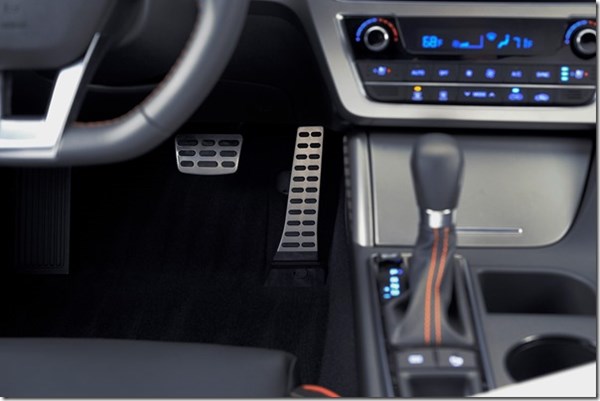2015 Hyundai Sonata Sport 2.0T
When the 2011 Hyundai Sonata was revealed, it was greeted with gasps.
#interior #electronics
When the 2011 Hyundai Sonata was revealed, it was greeted with gasps. It was hard to imagine that any company would come out with a vehicle with lines that were so exaggerated, so expressive, so baroque. Especially Hyundai, which had been putting out cars that appeared as though they had been designed by several committees, each of which was given a section of the car to execute, none of whom communicated with one another.
Sometimes the results were odd. Sometimes the results were innocuous.
Never were the results what the 2011 Sonata achieved.
It was a wonder.

2011 Hyundai Sonata
When the seventh-generation, 2015 Sonata was revealed, it was greeted with, comparatively speaking, yawns.
It was as though there were underlying expectations that things would get even more formed, more extreme, more outré.
Look at it this way: there are few available places to go when you’ve got this going:

“I Ran (So Far Away)”
In my estimation, the 2015 Sonata design is more confident, more grown-up. They don’t have to prove that they’ve got the chops in the design studio by going to some exotic antipodes of geometry.
This isn’t exactly a suit-and-tie. But it doesn’t have to stretch for its style.

2015 Hyundai Sonata
Arguably, one of the places that Hyundai went over the top was on the development of the ride and handling system. First know that this is an exceedingly stiff platform, made with more than 50% advanced high-strength steel. (Hyundai owns a steel company, so they know more than the average company about steel grades.)
Bottom line is that this Sonata has 41% better torsional rigidity and 35% greater bending strength than its predecessor.
.jpg;maxWidth=600)
Then they revised the multilink rear suspension, and not in a minor way: for example, there are dual lower suspension arms in place of the single-arm design that had been there. There are front sub-frame bushings that are 17% stiffer than those they replace, which improves the steering. That’s for all trim levels. The Sport 2.0T, which I had, features a sport-tuned suspension, 12.6-inch front brakes (the other models are 12.0-inch), and a rack-mounted, dual-pinion electric power steering system (the other models have a column-mounted system).
As for the over-achievement: Yes, they tested the car at its facilities in Namyang, Korea. Yes, they ran it at their proving grounds in Mojave, California. But they also ran it at a test center at the Nurburgring. Seriously?
Yes, the Sport 2.0T has a D-cut steering wheel and paddle shifters. Yes, there is a 2.0-liter, turbocharged gas direct-injected four cylinder engine. Yes, there are quad exhaust tips coming out of the edition-only rear fascia and 18-inch alloy wheels.

But this is a four-door sedan. The sort of thing that you commute in on car-choked highways, not on twisty, turny two-lane roads through the mountain passes. This is a car that goes up against the Camry, Accord, Altima, Fusion, Malibu, and Passat in the showroom, not a ZR1. This is a car that offers a sizable 16.3-cu. ft. of cargo volume, which means plenty of groceries. It has 106.1-cu. ft. of passenger volume, which means that the kids have space that doesn’t mean they’re on top of each other in the back seat.
Presumably, if you have a place at the Nurburgring, you use it.
For a family sedan, the Sport 2.0T looks sporty. For a family sedan, the Sport 2.0T has a bit of the proverbial pep to its step.
But at the end of the day (as well as at the start and in the middle), it is a family sedan.
A solid sensible choice. That happens to be somewhat sporty, to boot.
Selected specs
Engine: 2.0-liter, Turbo I4
Material: Aluminum block and head
Horsepower: 245 @ 6,000 rpm
Torque: 260 lb-ft @ 1,350-4,000 rpm
Transmission: Six-speed automatic
Steering: Electrically assisted rack-and-pinion
Wheelbase: 110.4 in.
Length: 191.1 in.
Width 73.4 in.
Height: 58.1 in.
EPA passenger volume: 106.1-cu. ft.
EPA fuel economy: city/highway/combined: 23/32/26 mpg
RELATED CONTENT
-
About the 2019 Toyota RAV4
Last year Buick sold 219,231 vehicles in the U.S.
-
2017 Honda Civic Hatch Sport Touring
Swindon, England, has what is called the “Magic Roundabout.” It consists of five roundabouts that surround a sixth.
-
EV Truck & SUV That Aren’t Rivian
A closer look at what Bollinger Motors is developing


.jpg;width=70;height=70;mode=crop)